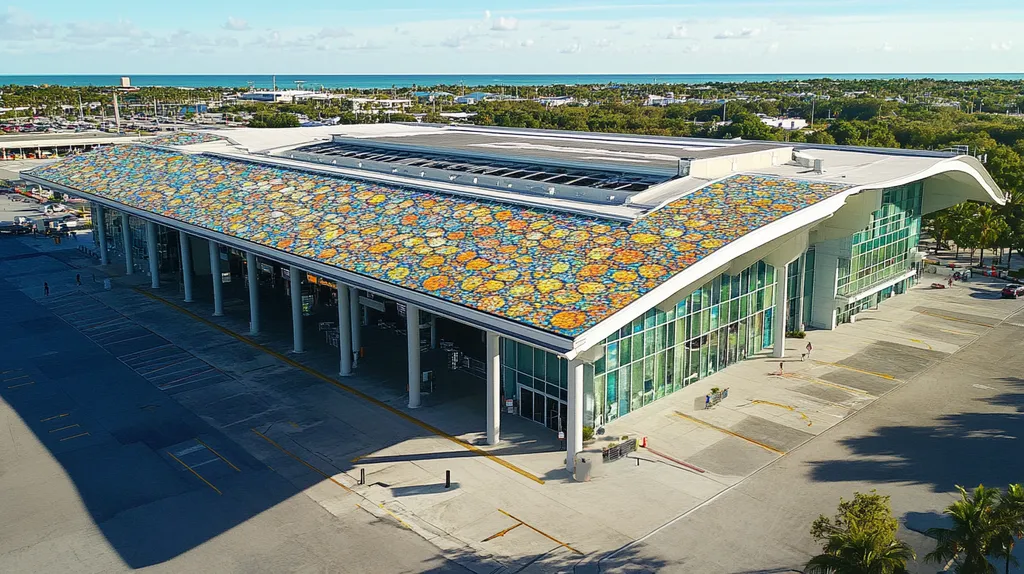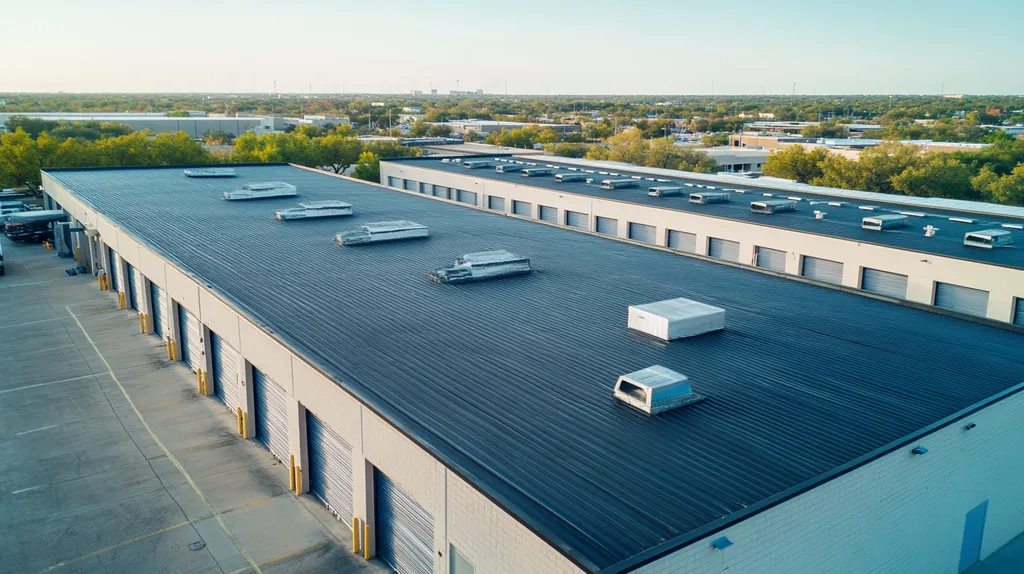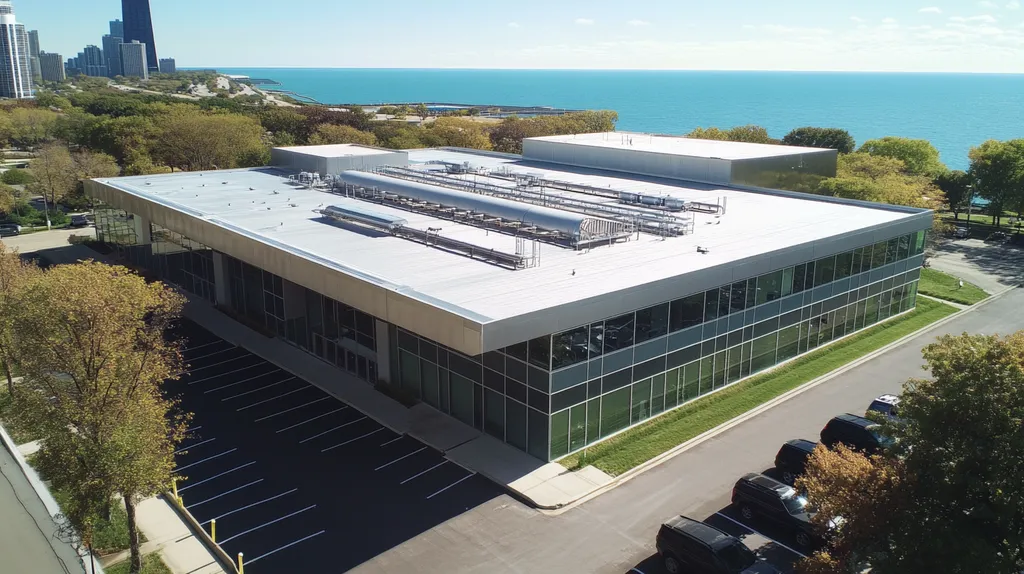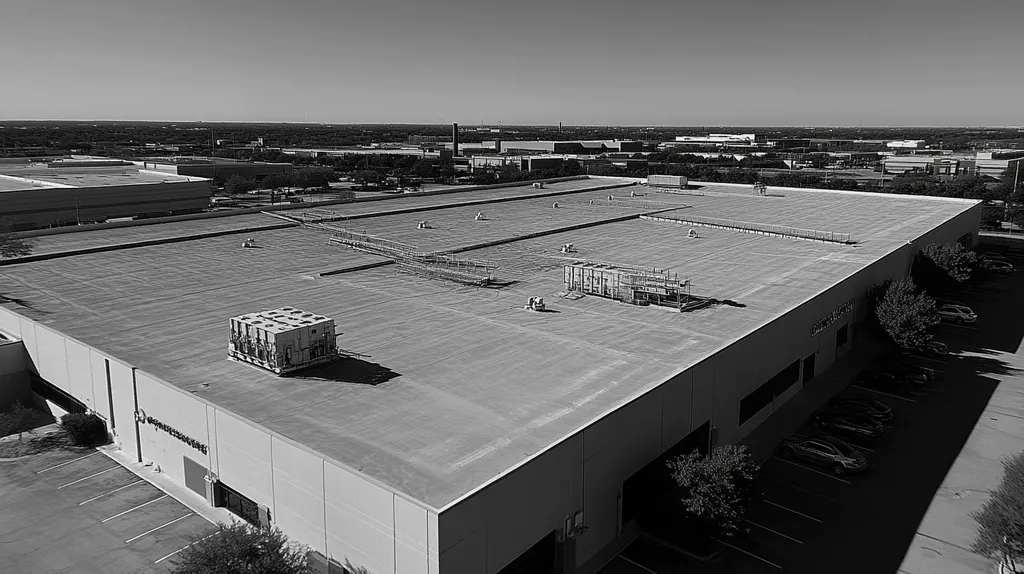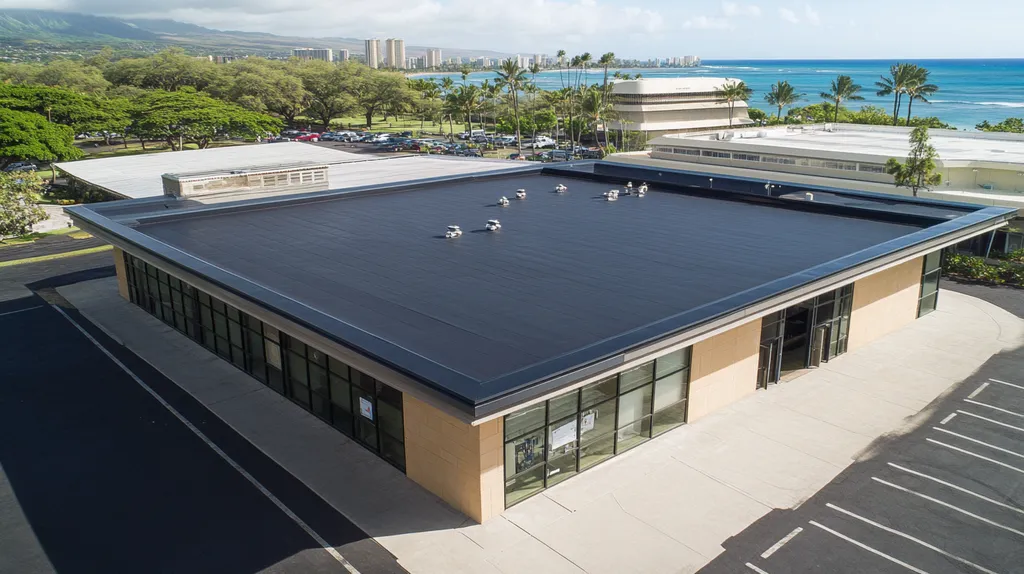Commercial roof failures cost U.S. businesses over $2.5 billion annually, with 70% of these incidents linked to inadequate damage assessments. Current evaluation practices often miss critical underlying issues, leading to premature system failures and expensive emergency repairs.
Traditional inspection methods, relying heavily on visual assessments and basic tools, frequently overlook moisture infiltration, structural weaknesses, and material degradation. This systematic failure to identify potential problems challenges the very foundation of commercial roof maintenance.
This analysis examines why conventional damage assessment protocols fall short, exploring the technical limitations, systemic issues, and missed opportunities that perpetuate this costly cycle of reactive repairs.
SECTION 1: CURRENT PRACTICES
Assessing potential roof damage is a critical task that many commercial property owners underestimate. Alarmingly, 60% of facilities incur unexpected repair costs due to inadequate evaluations. Current assessment methods, such as visual inspections and infrared scans, often fail to detect serious underlying issues, which can lead to costly decisions impacting budgets and safety. Recognizing these limitations is essential for informed damage assessment.
Visual Inspections and Limitations
Visual inspections are the most prevalent method for evaluating commercial roofs. During these assessments, technicians examine the roof’s surface for visible signs of damage. However, this approach frequently misses critical underlying issues, such as moisture that may be trapped within the roofing layers.
For example, while a technician may identify surface cracks, they might overlook significant water intrusion that could jeopardize the roof’s structural integrity. Such oversights can result in premature roof failure and expensive repairs in the future.
The effectiveness of visual assessments is further complicated by weather conditions. Rain, snow, or extreme temperatures can obscure damage, making it challenging to obtain an accurate evaluation of the roof’s condition.
Consequently, relying solely on visual inspections increases the risk of undetected damage, leading to operational disruptions and potentially impacting business continuity.
Infrared Scans: Common Practices
Infrared scans are increasingly utilized to identify moisture intrusion in commercial roofing. This technology detects temperature variations, helping to reveal hidden issues beneath the roof surface. Nevertheless, infrared scans have their share of limitations.
For optimal results, infrared scans should be conducted during cooler nighttime temperatures, but scheduling challenges can often push these assessments into less favorable conditions.
Moreover, the accuracy of infrared scans can be compromised by surface moisture resulting from recent rain or cleaning, potentially leading to false positives. This complexity complicates the decision-making process regarding repairs.
While infrared technology certainly adds value to roof evaluations, it should not be the sole method employed. A comprehensive assessment combined with other inspection techniques is necessary to uncover the full extent of potential damage (source: Procore).
Subjective Technician Opinions
The evaluation of roof damage often hinges on the subjective opinions of technicians, leading to inconsistencies in assessments. Different technicians may interpret what constitutes significant damage in varying ways, which can pose challenges for property owners.
For instance, one technician might recommend immediate repairs based on their experience, while another could consider the same condition acceptable for further monitoring. This lack of standardization can cause confusion and lead to misinformed decisions that affect budgets and safety.
Additionally, personal biases may influence technicians’ assessments. Their backgrounds, specific training, and familiarity with particular roofing systems can shape their evaluations, making the process even less consistent.
To minimize these discrepancies, establishing clearer guidelines and standards for assessing roofing conditions is crucial for enhancing the reliability of evaluations and ensuring more informed decision-making.
SECTION 2: SYSTEMIC ISSUES
In the commercial roofing sector, the stakes are high when it comes to evaluating potential damage. Inadequate assessment practices can lead to undetected issues that may cost property owners significantly; a recent study indicated that nearly 30% of commercial roofs face hidden problems that are only discovered later, often resulting in expensive repairs. This section highlights the critical problems associated with the lack of standardization in assessments, the excessive dependence on visual data, and the challenges in recognizing hidden damage.
Lack of Standardization in Assessments
The commercial roofing industry is plagued by inconsistent assessment practices. Various contractors and evaluators apply different criteria, leading to unreliable and varied results. For example, one contractor might flag particular surface cracks as urgent, while another may dismiss them entirely.
This inconsistency creates obstacles for property owners and facility managers in making informed decisions. Without a standardized assessment protocol, the chance of missing vital issues increases, potentially resulting in financial repercussions and safety risks.
Implementing a uniform approach could significantly improve evaluation accuracy. By establishing clear, industry-wide guidelines, stakeholders can assess damage more effectively and prioritize repairs based on urgency. A consistent methodology would also allow for fair comparisons between different properties.
Standardization acts as a foundation for effective damage assessments, fostering reliability and trust across the industry. Adopting agreed-upon benchmarks is essential for improving the overall integrity of roof evaluations.
Overreliance on Visual Data
There is a prevailing reliance on visual inspections in damage assessments, which often leaves critical gaps in detection. While visible wear and tear is important, it doesn’t always reveal the root issues lurking beneath the surface. Water damage, for instance, may remain hidden until it causes severe structural problems.
This focus on observable evidence alone can mislead property owners. A roof may appear sound while concealing significant issues like mold growth or weakened structural supports. Consequently, an evaluation process that prioritizes only visual data diminishes thoroughness and accuracy.
Inadequate Identification of Hidden Damage
A major challenge in roofing assessments is detecting hidden damage. Many inspectors frequently overlook potential risks tied to underlying structural or internal issues that are not immediately visible. This can spell trouble for property owners and facilities managers.
SECTION 3: MISSED OPPORTUNITIES
Neglecting comprehensive assessments in commercial roofing can lead to significant financial repercussions. Research indicates that approximately 60% of commercial roofs suffer premature failure due to inadequate evaluation practices. Property owners and facility managers risk incurring unplanned expenses and worsening maintenance challenges when critical assessments—such as laboratory testing and structural analysis—are overlooked. Identifying these missed opportunities is vital for optimizing repair strategies and safeguarding investments.
Neglecting Laboratory Testing
Laboratory testing is essential for uncovering key insights about roofing materials and their vulnerabilities. Without these assessments, property owners may fail to recognize hidden issues such as material degradation or contamination. Regular lab evaluations can determine the integrity of roofing systems, yet many assessments overlook this critical step.
This negligence can lead to inappropriate repair techniques that exacerbate deterioration and inflate long-term costs. By incorporating laboratory testing, property owners can proactively identify underlying issues before they develop into major failures.
Additionally, laboratory tests yield actionable data regarding a roof’s lifespan and performance in varying conditions. Understanding how materials withstand weather, chemical exposure, and stress is invaluable in shaping effective maintenance or replacement plans.
Incorporating routine laboratory testing into evaluations paves the way for improved roof longevity and performance, ensuring that repairs are both timely and effective.
Ignoring Structural and Chemical Analysis
Current roofing evaluations often emphasize visible damage while neglecting the crucial aspects of structural and chemical integrity. A comprehensive structural assessment is essential; undetected issues, such as a weakened roof deck, may not show visible signs but can compromise the entire system under stress.
Moreover, chemical analysis can identify harmful substances in roofing materials that exacerbate damage. Without these evaluations, repairs may only mask underlying problems, jeopardizing both safety and investments.
Building codes frequently mandate specific structural integrity tests, making compliance an essential element of any roofing evaluation. Property owners who overlook these requirements face potential legal and financial ramifications. Conducting thorough structural and chemical analyses ensures not only the safety of the building but also its resilience.
Emphasizing structural and chemical analysis ultimately facilitates more informed decision-making, resulting in substantial cost savings over time.
Overlooking Long-Term Cost Savings
Property owners often concentrate solely on immediate repair expenses, neglecting the long-term financial implications. Failing to address maintenance needs can result in escalating costs in the future. For example, ignoring early signs of roof failure can lead to significant water damage, requiring extensive and costly repairs.
By prioritizing thorough evaluations at the outset, property managers can avert unforeseen costs. Identifying vulnerabilities early allows for more effective resource allocation and proactive management, preserving roof integrity over time.
A well-maintained roof also enhances a building’s energy efficiency, leading to reduced operational costs. Properties that lack comprehensive assessments may miss out on significant opportunities for energy-efficient upgrades, which could substantially decrease utility expenses.
In summary, integrating long-term cost considerations into roofing assessments is crucial. Addressing issues before they escalate can lead to considerable savings in both maintenance and operational expenditures.
SECTION 4: ROOT CAUSES
Effective damage assessment for commercial roofs is crucial; however, existing practices often overlook significant underlying issues. Alarmingly, nearly 85% of roofing failures can be traced back to foundational misjudgments. This oversight not only leads to increased repair costs but also jeopardizes the safety of the building and its occupants. Three primary root causes contribute to this problem: inadequate training, limited use of advanced technology, and pressure for quick solutions. Addressing these factors is essential for enhancing assessment accuracy and ensuring long-term roof performance.
Inadequate Training and Expertise
The lack of specialized training among roofing professionals can severely hinder effective damage assessments. Many technicians enter the field with insufficient knowledge about roofing systems, which directly affects their ability to identify subtle yet serious issues. A seemingly minor roof leak might be dismissed due to this lack of insight, leading to extensive water damage over time.
Furthermore, ongoing education is often neglected, preventing workers from staying up-to-date with the latest industry standards and best practices. This gap in knowledge results in missed opportunities to detect potential problems early. Providing regular training for roofing professionals is vital, as it directly influences the reliability of their assessments.
Contractors should prioritize hiring certified professionals who demonstrate expertise in specific roofing systems. This focus can significantly enhance assessment accuracy, preventing costly repairs down the road. Investing in comprehensive training ensures that the entire team can recognize and address not only visible flaws but also the underlying causes of roofing issues.
Ultimately, well-trained professionals can make informed decisions that save property owners money and enhance building safety. By improving training and expertise, the commercial roofing industry can transform its assessment practices for the better.
Limited Use of Advanced Technology
The roofing industry has made strides in integrating advanced technology, yet many evaluations fail to leverage these tools effectively. Technologies such as drones, thermal imaging, and moisture detectors offer invaluable insights unattainable through traditional methods. For instance, thermal imaging can reveal hidden leaks invisible to the naked eye, enabling more accurate assessments.
However, the adoption of these technologies remains limited, often due to costs or resistance to change. Many property owners and managers still rely on basic inspection methods, which can lead to missed indicators of damage. This reluctance to embrace advanced technology ultimately prolongs existing issues and increases repair expenses.
Moreover, ensuring that technicians are trained to utilize advanced tools is essential. A skilled technician equipped with the right technology can conduct comprehensive damage assessments, thus significantly improving accuracy. Businesses that adopt such technologies enhance not only their assessment processes but also their preparedness for future roofing solutions.
A shift toward incorporating advanced technology is crucial for more effective decision-making and predicting long-term performance. As the industry evolves, embracing these innovations will be vital for maintaining the integrity of commercial roofs.
Pressure for Quick, Cost-Effective Solutions
The roofing industry often faces immense pressure to deliver quick and economical solutions, which can compromise thorough assessments. Property owners and managers may prioritize short-term savings, leading to rushed evaluations that overlook critical signs of damage. For example, opting for a low-cost repair without conducting a proper assessment may mask underlying issues, resulting in additional complications.
This haste can create a false sense of security regarding the roof’s condition. Without diligent evaluations, significant damage can progress unnoticed, ultimately resulting in costly repairs later. Many facilities face this issue when leaks are patched without addressing the root cause, often inviting recurring problems.
To counteract this trend, stakeholders must emphasize the importance of comprehensive assessments. Investing time and resources upfront can save buildings from significant damage and extensive expenditures in the future. A proactive approach fosters a culture that prioritizes long-term stability and safety.
Balancing cost considerations against thorough inspections is essential. Decisions driven solely by price often lead to more significant issues down the road, underscoring the need for processes that value quality evaluations over speed.
DATA DRIVEN EVIDENCE
In the realm of commercial roofing, ineffective assessments can lead to devastating financial repercussions. Over 60% of facility managers have reported facing significant issues stemming from inadequate damage evaluations. Accurate assessments are not just beneficial—they are essential for ensuring effective repairs and preventing larger, costly problems in the future. By utilizing data-driven techniques, property owners can improve their understanding of roofing health, enabling them to make informed decisions that transcend reliance on visual inspections.
Laboratory Analysis and Core Sampling
Laboratory analysis and core sampling signify a paradigm shift in accurately assessing roof damage. Core sampling involves extracting small cylindrical sections of roofing material for detailed examination. This method can unveil structural problems hidden from view, such as moisture infiltration or material degradation.
Through thorough laboratory analysis, property managers gain precise insights into material composition, helping to identify vulnerabilities that compromise the roof’s integrity. For example, testing can uncover insulation that retains excessive moisture, potentially leading to mold growth and further complications.
By adopting these advanced methods, property owners can bolster their repair strategies and enhance the long-term durability of their roofs. Tailoring maintenance plans based on specific data-driven insights helps mitigate unexpected failures and extends the overall lifespan of roofing systems.
Ultimately, integrating core sampling and laboratory analysis as standard practices represents a critical advancement in roof management. These techniques empower companies to proactively address potential issues, safeguarding their investments and ensuring operational continuity.
Comprehensive Condition Reports
Comprehensive condition reports offer an in-depth examination of a roof’s current status by integrating visual inspections with sophisticated technologies like thermal imaging and moisture meters. This holistic approach captures vital data often missed in traditional inspections. By compiling this array of information, reports present a complete overview of any existing or emerging issues.
Such reports not only pinpoint areas requiring immediate attention but also monitor the roof’s performance over time. For example, a condition report may indicate recurring leaks in specific sections, facilitating targeted interventions. This organized data helps prioritize repairs based on urgency and likelihood of further damage.
Moreover, condition reports are invaluable for budget planning regarding future repairs or roofing replacements. Property owners can utilize this data to support financing discussions or seek additional funding. Providing clear visibility into roofing conditions empowers property owners to make more informed financial decisions.
In summary, condition reports serve as a crucial tool for recognizing trends and preemptively addressing potential failures, enabling timely intervention and strategic planning. With access to comprehensive data, property managers significantly reduce the risk of unexpected and costly repairs.
Historical Data and Predictive Analytics
Leveraging historical data in conjunction with predictive analytics transforms the maintenance landscape for commercial roofs. By analyzing past performance and failure rates, property managers can identify patterns indicative of future problems. Historical insights contextualize the unique challenges of each roof, forming the basis for informed decision-making.
Predictive analytics utilize algorithms to forecast potential issues based on current condition reports and historical data. This proactive methodology allows facility managers to foresee maintenance requirements before minor concerns escalate. For instance, if the failure rate of a specific roofing material appears to be increasing, managers may prioritize monitoring or preemptively replace those sections.
Incorporating this data-driven approach ensures that roof maintenance is proactive rather than reactive, enhancing operational efficiency. By directing resources toward high-risk areas, managers achieve better budget allocation and workforce deployment, minimizing impact on business operations.
In conclusion, harnessing historical data and predictive analytics offers strategic advantages in managing commercial roofs. This empowers property owners to refine their maintenance strategies, staying ahead of potential issues and effectively protecting their valuable assets.
SECTION 6: ALTERNATIVE SOLUTIONS
With the increasing frequency and intensity of severe weather events, reliable roof damage assessments are more critical than ever for property owners. Traditional evaluation methods often miss hidden issues, leading to expensive repairs and safety risks. Fortunately, innovative solutions can reshape the landscape of commercial roofing assessments, ensuring that roofs receive the attention they need before major damage occurs. This section delves into integrated assessment approaches, advanced diagnostic tools, and proactive maintenance strategies that have the potential to transform how evaluations are performed.
Integrated Assessment Approaches
Integrated assessment approaches blend various evaluation techniques to deliver a comprehensive overview of a roof’s condition. By fostering collaboration among roofing professionals, engineers, and facility managers, these methods enhance the ability to identify potential damage effectively.
This holistic approach begins with visual inspections, augmented by data from building management systems. Often, roofs conceal problems like moisture accumulation that can be detected through multifaceted assessments. Historical performance data from roofing materials can also guide targeted evaluations.
For example, integrating thermal imaging into assessments highlights areas of heat loss, signaling potential insulation or moisture challenges. By coordinating efforts during evaluations, stakeholders can significantly minimize the risk of missing critical damage, thus enhancing safety and reducing eventual costs.
Adopting an integrated framework necessitates openness to new methodologies, ensuring that all property stakeholders collaborate on assessments. Such a shift cultivates a culture that transforms proactive maintenance into standard practice rather than an exception.
Use of Advanced Diagnostic Tools
Advanced diagnostic tools are revolutionizing roof damage assessments. Technologies such as drones, infrared cameras, and moisture meters provide precise insights, moving beyond the limitations of outdated visual inspections. These innovative tools can expose issues that may be hidden from straightforward observation.
Drones efficiently survey extensive commercial roofs, capturing real-time imagery that reflects the overall condition of the surface. This technology not only reduces inspection time significantly but also boosts data accuracy. Additionally, drones can safely access difficult-to-reach areas, minimizing the risks associated with conventional inspection methods.
Thermal imaging cameras play a critical role by detecting temperature discrepancies on the roof surface, indicating concealed moisture that could lead to leaks. By permitting non-invasive assessments, these tools help maintain the structural integrity of roofs.
Incorporating these advanced technologies into routine evaluations can substantially decrease unexpected repair costs. Early diagnosis of potential issues allows property owners to implement preventive measures instead of facing costly emergency repairs later on.
Proactive Maintenance and Planning Strategies
Implementing proactive maintenance and planning strategies is vital for protecting commercial roofs against long-term damage. Establishing a scheduled maintenance plan that includes regular inspections and timely repairs can significantly enhance the longevity of a roofing system.
Property owners should prioritize preventative measures rather than solely addressing reactive solutions. This approach involves setting specific timelines for inspections, analyzing historical weather data, and understanding the unique vulnerabilities of various roofing systems.
Moreover, utilizing warranties and adhering to manufacturer recommendations can create a framework for effective ongoing maintenance. Routine inspections and repairs can tackle minor issues before they develop into substantial problems.
Adopting a proactive mentality towards roof management allows property owners to reduce total ownership costs significantly. Early detection paired with consistent maintenance ensures optimal roof performance, ultimately lowering the overall risks associated with roofing systems.
Moving Forward
The commercial roofing industry stands at a critical juncture, with assessment failures costing businesses over $2.5 billion annually in preventable damage.
Current evaluation practices, heavily dependent on visual inspections and outdated methodologies, consistently fail to identify underlying issues that lead to catastrophic failures.
The integration of advanced diagnostic tools, comprehensive laboratory testing, and data-driven analytics represents a clear path forward for the industry.
Without widespread adoption of these evidence-based assessment protocols, commercial properties will continue facing escalating repair costs, shortened roof lifespans, and increased safety risks.
Property owners and facility managers must prioritize standardized, technology-enabled evaluations to protect their investments and ensure the long-term integrity of their roofing systems.
FREQUENTLY ASKED QUESTIONS
Q. What are the limitations of visual inspection for a commercial roof?
A. Visual inspections often miss critical hidden damage such as moisture intrusion. Surface cracks may be identified, but deeper issues like structural weaknesses or water damage are frequently overlooked, potentially leading to costly future repairs and jeopardizing safety.
Q. How does a lack of standardization affect commercial roof assessments?
A. Inconsistent assessment practices among evaluators lead to unreliable evaluations. Without standard protocols, important damage may be missed, resulting in financial repercussions and unsafe conditions for property owners and facility managers.
Q. What are the consequences of ignoring laboratory testing for commercial roofs?
A. Ignoring laboratory testing can lead to undetected material degradation and contamination. This oversight may result in inappropriate repair techniques, escalating long-term costs and reducing the roof’s overall lifespan and performance.
Q. How does inadequate training impact commercial roof evaluations?
A. Insufficient training among roofing professionals can prevent the accurate identification of significant issues. This lack of expertise may result in missed signals that could escalate into major problems, ultimately leading to costly repairs and safety hazards.
Q. What role does historical data play in commercial roof management?
A. Historical data helps identify patterns and potential future problems in roof performance. By analyzing past conditions and failures, property managers can implement more effective maintenance strategies to prevent costly repairs and enhance the longevity of commercial roofs.
Q. How can advanced diagnostic tools improve roof damage assessments?
A. Advanced diagnostic tools like drones and infrared cameras allow for precise detection of hidden issues. These technologies provide comprehensive insights that enhance assessment accuracy and help property owners implement early repairs, thus reducing long-term costs.
Q. What are the benefits of proactive maintenance planning for commercial roofs?
A. Proactive maintenance ensures regular inspections and timely repairs, which significantly enhance roof longevity. This approach minimizes costly repairs and helps in maintaining optimal roof performance, ultimately leading to reduced total ownership costs.

